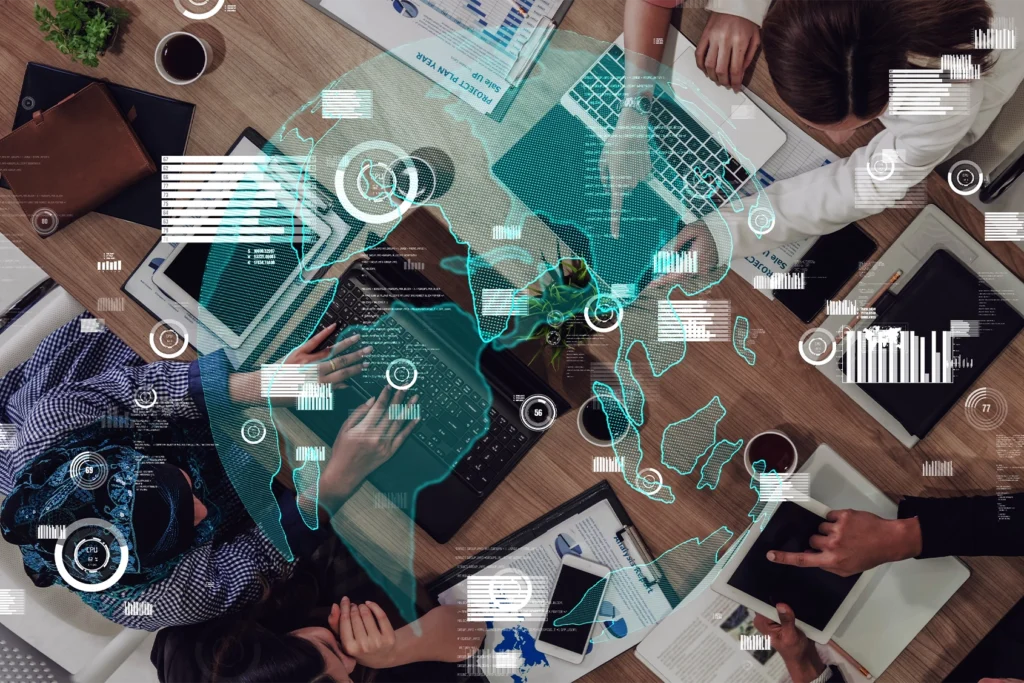
How Virtual Events Are Bridging The Global Workforce Gap
- by GlobalMeet Blog Team
- ,
The Evolving World of Work
The workplace has undergone a seismic shift over the past few years. From traditional, office-bound models to more flexible arrangements, the concept of where and how we work has fundamentally changed. While Return to Office mandates are happening, smart organizations are realizing that the best talent can be sourced from anywhere. Not just within 50 miles of the office.
Employees now expect flexibility in how they work, while employers are embracing the benefits of distributed teams. With access to wider talent pools and reduced overheads, working globally is good business sense. However, these changes have also highlighted the importance of broad reaching communication tools, efficient digital collaboration, and accessible training solutions.
This is where virtual events come into play, providing a scalable and customizable way for organizations to engage their teams, customers, and communities, regardless of location.
Virtual Events and Hybrid Working: A Natural Fit
Hybrid working thrives on the ability to communicate and collaborate without being physically co-located. Virtual events support this model by offering platforms where employees can attend meetings, training sessions, and networking events in real-time or asynchronously.
Whether it’s a global town hall, a team-building workshop, or an industry conference, virtual events make it possible for all participants to join on equal footing. Unlike traditional in-person events that may exclude those unable to travel due to time, cost, or visa issues, virtual events ensure broader participation.
For hybrid organizations, this means that talent in different time zones and regions can stay informed, connected, and engaged, resulting in a more cohesive and productive workforce that feels valued and included.
Global Networking Opportunities
One of the standout benefits of virtual events is their power to democratize networking. Historically, professional networking heavily depended on in-person interactions at events, conferences, and workshops — experiences often out of reach for professionals in developing regions or those working for smaller organizations with limited budgets.
Virtual events remove these barriers, enabling professionals to connect, collaborate, and learn from one another regardless of where they are in the world. From live Q&A sessions to breakout rooms and AI-driven matchmaking, digital platforms now offer engaging and effective experiences.
This equal access not only helps individuals expand their professional horizons but also allows organizations to tap into fresh perspectives and underutilized talent pools.
Training and Development Across Borders
The global workforce is facing a critical skills gap. As industries evolve rapidly, keeping pace with technological advancements and new business models is a constant challenge. Virtual events are proving instrumental in addressing this gap through scalable training and development programs.
Online learning platforms and event tools make it easy for companies to deliver interactive webinars, certification courses, and skill-building workshops to employees across different regions. These sessions can be tailored to specific cultural or language needs and accessed on-demand, making learning more flexible and inclusive.
A multinational company leveraging the right software can run a virtual leadership development program that brings together employees from Europe, Asia, and Africa, fostering not only skills growth but also cross-cultural understanding and collaboration.
Digital Collaboration Made Easy
Virtual events are more than just one-off experiences; they are part of a broader ecosystem of digital collaboration. Integrated with other tools like project management platforms, cloud-based file sharing, and real-time chat apps, virtual event platforms contribute to a seamless work environment.
Features such as collaborative whiteboards, live polls, shared documents, and post-event discussion forums enhance engagement and ensure that knowledge is retained and acted upon long after the event ends.
Moreover, advances in AI and analytics help organizations understand participation trends, learning outcomes, and employee sentiment, leading to more targeted and effective workforce strategies.
The Future of Global Collaboration
Looking ahead, it seems certain that the role of virtual events in workplace development is only set to grow. As more organizations embrace hybrid and remote models, they will increasingly rely on sophisticated virtual event tools to bridge geographic divides.
Emerging technologies promise to make virtual events even more immersive and interactive, offering new ways to train, collaborate, and connect. Imagine attending a virtual conference where you can explore booths, engage with colleagues and industry professionals, and attend panel discussions — all within a virtual environment.
Furthermore, the rise of AI-driven personalization will allow virtual events to offer tailored content, networking suggestions, and learning paths, enhancing the experience for each participant.
As environmental concerns grow, virtual events also offer a more sustainable alternative to traditional events by reducing the need for travel and physical infrastructure. This aligns with broader goals and helps organizations operate more responsibly.
Conclusion
In a world where the only constant is change, virtual events have become an essential tool for bridging the global workforce gap. They support hybrid working models, democratize access to networking and development opportunities, and foster meaningful collaboration across time zones and borders.
By embracing virtual events, organizations can not only address immediate challenges such as skills shortages and employee disengagement, but also build more inclusive, agile, and resilient workforces for the future.
As technology continues to evolve, so too will the possibilities for virtual and hybrid events. The organizations that invest in these solutions today will be the ones best equipped to thrive in the dynamic world of work tomorrow.


